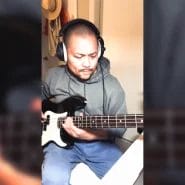If you’ve never transcribed a horn solo before, you’re missing out on one of the most powerful tools for shaping your phrasing and musicality as a bassist.
One of my favorite solos to start with is Chet Baker on Autumn Leaves. His phrasing is lyrical. His note choices are often simple but incredibly expressive. And as a bonus—he’s mostly diatonic, which makes his solos easier to transcribe, but no less profound.
In this Bass Shed Spotlight, I’ll walk through five key takeaways from a small section of Chet’s solo—lessons that can immediately improve how you shape lines, create space, and make your bass solos sing.
Let’s dive in.
What I Learned From A Chet Baker’s Autumn Leaves solo

A while ago, I transcribed a snippet of Chet Baker’s solo.
Autumn Leaves is a Jazz standard. The concepts that Chet Baker is using over this tune are practical and musical. So, you can start using them today over any chord progression. And your solos will immediately start sounding better.
But first, here are the musicians on this recording. They’re crushing it on this recording. I recommend that you check it out.
- Chet Baker (trumpet)
- Paul Desmond (alto sax)
- Hubert Laws (flute)
- Bob James (keyboard)
- Ron Carter (contrabass)
- Steve Gadd (drums)
Concept #1: When you can sound good with diatonic lines, a small amount of chromaticism can have a huge impact
What you’ll see in the transcription, is that Chet Baker’s solo is very inside. He isn’t using too much chromaticism.
When he does use it, it is enough to make the listener’s ear go, “what was that!?”
For the most part, the notes of this entire section of his solo is in Ab Major.
He sometimes uses chromatic approach tones when he approaches F, Eb, and C.
Although the notes of his solo are in Ab for the most part, the chromatic approach tones emphasize a F Minor sound.
Whenever you’re practicing and exploring new sounds, try to stay diatonic for an extended period of time before introducing chromatic notes.
Concept #2: Diminished Arpeggios imply a Dominant 7b9 Chord
Diminised arpeggios are common among Jazz vocabulary.
When you play a diminished arpeggio starting on the 3rd, 5th, b7, or b9 of a dominant 7 Chord, you end up outlining a 7b9 chord.
This sound has a strong pull to the tonic chord, wether the tonic is major or minor. It’s also an effective way to introduce tension in a subtle way.
Chet Baker uses diminished arpeggios a few times in this short snippet of his solo.
Whenever you want to create movement in your lines, try inserting a diminished arpeggio to imply a dominant 7b9 sound.
Concept #3: You don’t need to play notes on every bar
Chet Baker leaves space in his solo in a way that makes it sound conversational.
Sometimes he’ll leave an entire measure of space. This allows the band to interact with what he’s playing.
Try practicing keeping your phrases either 2 bars or 3 bars in length. And explore placing these short phrases in different locations in the bar.
Practicing leaving space will help you to focus on creating simple melodic statements. Space is underrated. Don’t sleep on space. It’s a powerful device in music.
Concept #4: A simple rhythm can seem like so much more if you add variations to your note durations
The rhythms in this part of Chet Baker’s solo aren’t complicated.
Although most of it focuses on eighth notes, Chet Baker varies it up using short and long tones.
This makes the rhythm swing harder and have forward motion.
Concept #5: Use the range of your instrument
One thing I love about the melodic aspect of Chet Baker’s solo is that it uses a full dynamic range.
In my personal experience, just by using the range of your instrument, you can keep the interest of your listener without having to play anything flashy.
Conclusion
It’s wild how much musical gold you can get from just a few bars of a Chet Baker solo.
His phrasing teaches you more than theory books ever could—how to leave space, how to make simple ideas sing, how to move a listener without overplaying.
Transcribing solos like this isn’t just about learning the notes—it’s about internalizing feel, flow, and freedom.
So grab your bass, listen deeply, and experiment with these concepts in your own voice. And next time you’re stuck for soloing ideas? Don’t just look at bass players—go lift from the horn players. That’s where the magic is.
Want more deep-dive musical reflections? Head to Creative Life & Tools →
Frequently Asked Questions
Why should bass players study Chet Baker solos?
Horn solos reveal phrasing, breath, space, and melodic shape in a way bass-only vocabulary can’t. Studying Chet Baker helps you play more lyrically, make clearer melodic statements, and avoid “running scales” when you solo.
What makes the Autumn Leaves solo a good starting point?
Chet’s lines are mostly diatonic, rhythmically clear, and easy to follow—yet still expressive. This makes it one of the most accessible solos to transcribe while still offering deep musical lessons.
How can I apply diminished arpeggios the way Chet Baker does?
Use diminished arpeggios built from the 3rd, 5th, b7, or b9 of a dominant chord. This creates a natural 7b9 tension that resolves beautifully into the tonic, giving your solos forward motion.
How do I practice leaving space like Chet Baker?
Create 2-bar or 3-bar phrases and intentionally leave full measures of silence between them. Space gives your ideas room to breathe, invites band interaction, and improves your dynamic control.
How can I make simple eighth-note lines sound more expressive?
Vary your note lengths. Mix short and long tones. Add subtle accents. Even a simple rhythm gains momentum when you shape the durations instead of playing everything evenly.









